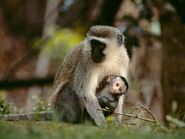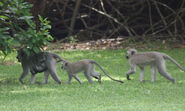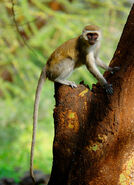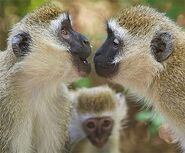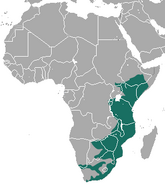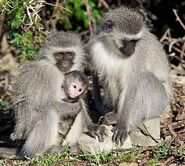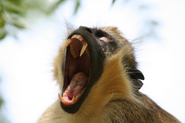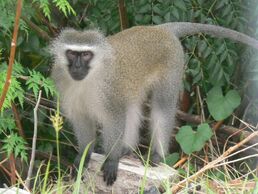
The vervet monkey (Chlorocebus pygerythrus), or simply vervet, is an Old World monkey of the family Cercopithecidae native to Africa. The term "vervet" is also used to refer to all the members of the genus Chlorocebus. The five distinct subspecies can be found mostly throughout Southern Africa, as well as some of the eastern countries. Vervets were introduced to Florida, Texas, Alabama, Louisiana, Arizona, California, Ascension Island, Cape Verde, Barbados, Saint Kitts, Bermuda, Bahamas, Cuba, Jamaica, Haiti, Dominican Republic, and Nevis. These mostly herbivorous monkeys have black faces and grey body hair color, ranging in length from about 50 centimetres (20 in) for males to about 40 centimetres (16 in) for females.
In addition to very interesting behavioral research on natural populations, vervet monkeys serve as a nonhuman primate model for understanding genetic and social behaviors of humans. They have been noted for having human-like characteristics, such as hypertension, anxiety, and social and dependent alcohol use. Vervets live in social groups ranging from 10 to 70 individuals, with males changing groups at the time of sexual maturity. The most significant studies done on vervet monkeys involve their communication and alarm calls, specifically in regard to kin and group recognition and particular predator sightings.
Physical Description[]
The vervet monkey has a black face with a white fringe of hair, while the overall hair color is mostly grizzled-grey. The species exhibits sexual dimorphism; the males are larger in weight and body length. Adult males weigh between 3.9 and 8.0 kg (8.6 and 17.6 lb), averaging 5.5 kg (12 lb), and have a body length between 420 and 600 mm (17 and 24 in), averaging 490 mm (19 in) from the top of the head to the base of the tail. Adult females weigh between 3.4 and 5.3 kg (7.5 and 11.7 lb) and average 4.1 kg (9.0 lb), and measure between 300 and 495 mm (11.8 and 19.5 in), averaging 426 mm (16.8 in).
Behavior[]
Social Behavior[]
When males reach sexual maturity, they move to a neighboring group. Often, males will move with a brother or peer, presumably for protection against aggression by males and females of the resident group. Groups that had previously transferred males show significantly less aggression upon the arrival of another male. In almost every case, males migrate to adjacent groups. This obviously increases benefits in regard to distance traveled, but also reduces the amount of genetic variance, increasing the likelihood of inbreeding.
Females remain in their groups throughout life. Separate dominance hierarchies are found for each sex. Male hierarchies are determined by age, tenure in the group, fighting abilities, and allies, while female hierarchies are dependent on maternal social status. A large proportion of interactions occur between individuals which are similarly ranked and closely related. Between unrelated individuals, there is female competition for grooming members of high-ranking families, presumably to gain more access to resources. These observations suggest individual recognition is possible and enables discrimination of genetic relatedness and social status. Interactions between different groups are variable, ranging from highly aggressive to friendly. Furthermore, individuals seem to be able to recognize cross-group vocalizations, and identify from and to which monkey each call is intended, even if the call is made by a subadult male which is likely to transfer groups. This suggests the members within a group are actively monitoring the activity of other groups, including the movement of individuals within a group.
Within groups, aggression is directed primarily at individuals that are lower on the hierarchy. Once an individual is three years or older, it is considerably more likely to be involved in conflict. Conflict often arises when one group member shows aggression toward a close relative of another. Further, both males and females may redirect aggression towards individuals in which both had close relatives that were previously involved in a conflict. This suggests complex recognition not only of individuals, but also of associations between individuals. This does not suggest recognition of other's individual kinship bonds is possible, but rather that discrimination of social relationships does occur.
Alarm Calls and Offspring Recognition[]
Vervet monkeys have four confirmed predators: leopards, eagles, pythons, and baboons. The sighting of each predator elicits an acoustically distinct alarm call. In experimentation with unreliable signalers, individuals became habituated to incorrect calls from a specific individual. Though the response was lessened for a specific predator, if an unreliable individual gives an alarm call for a different predator, group members respond as if the alarm caller is, in fact, reliable. This suggests vervet monkeys are able to recognize and to respond to not only the individual calling, but also to the semantics of what the individual is communicating. It is believed that vervet monkeys have up to 30 different alarm calls. In the wild vervet monkeys have been seen giving a different call when seeing a human being approaching, leading to researchers believing that vervet monkeys may have a way of distinguishing between different land and flight predators.
Mothers can recognize their offspring by a scream alone. A juvenile scream will elicit a reaction from all mothers, yet the juvenile's own mother had a shorter latency in looking in the direction of the scream, as well as an increased duration in her look. Further, mothers have been observed to help their offspring in conflict, yet rarely aided other juveniles. Other mothers evidently can determine to which mother the offspring belongs. Individuals have been observed to look towards the mother whose offspring is creating the scream.
Kin Relationships[]
Siblings likely provide the prevailing social relationships during development. Within social groups, mother-offspring and sibling interactive units are distinct groups. The sibling interaction are heavily supportive and friendly, but do have some competition. Contests primarily involve postweaning resource allocation by the common mother. For example, siblings have conflict over grooming time allocated by their mother. Offspring are usually not born in extremely close proximity due to the interbirth period of the mother. This time can be reduced by use of an allomother. The clarity of the familial and sibships within a group may act as a form of alliance, which would come at relatively low cost in regards to grooming. Other alliances are shown through conflict with aggressive individuals that have acted against a closely related sibling.
Ecology[]
Diet[]
The vervet monkey eats a primarily herbivorous diet, living mostly on wild fruits, flowers, leaves, seeds, and seed pods. In agricultural areas, vervets become problem animals, as they will raid bean crops, peas, young tobacco plants, vegetables, fruit, and various grain crops. Carnivorous aspects of their diet include grasshoppers and termites. Raids of cattle egrets and weaver bird nests have been observed where the vervets will eat the eggs and chicks.
Distribution and Habitat[]
The vervet monkey ranges throughout much of Southern and East Africa, being found from Ethiopia, Somalia and extreme southern South Sudan, to South Africa. It is not found west of the East African Rift or the Luangwa River, where it is replaced by the closely related malbrouck (C. cynosuros). The vervet monkey inhabits savanna, riverine woodland, coastal forest and mountains up to 4000 m (13,100 ft). They are adaptable and able to persist in secondary and/or highly fragmented vegetation, including cultivated areas, and sometimes are found living in both rural and urban environments. Annual home range size has been observed to be as high as 176 ha with an average population density of 54.68 animals/km².
Introduced vervet monkeys are naturalized in Ascension Island, Cape Verde, Bermuda, Barbados, Bahamas, Cuba, Jamaica, Haiti, Dominican Republic, and Saint Kitts and Nevis. Dania Beach, Florida is home to about 20 introduced vervets.
